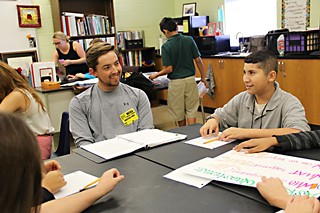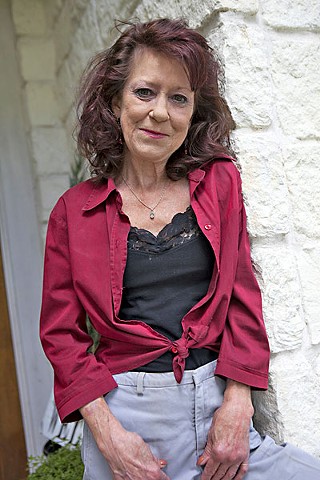Changing Directions
Community-based programs aim to redirect the 'school-to-prison pipeline'
By Dagny Zenovia, Fri., June 6, 2014

During the last two years, Kaelyn and Kathy Michals endured what seemed an endless emotional landslide. In 2012, Thomas Luke Michals – Kathy's husband and Kaelyn's father – committed suicide. At Bowie High School, Kaelyn, who suffers from bipolar disorder, began smoking, taking Xanax, and cutting class. "In ninth grade I started skipping class, because I wanted to be with my friends," said Kaelyn. "In 10th grade, when my dad died, I started using drugs."
Kaelyn says she was constantly bullied by her peers, and punished by administrators for not fitting the mold in high school. She was removed from her 10th-grade classroom and placed in a tutoring program housed in a portable building. She was not receiving any academic or social support, and was isolated from the rest of the school. She fell further behind in her studies – and was eventually expelled. Said her mother, "No one ever took into account what was happening in her own personal life."
Kaelyn was in danger of entering what has often been called "the school-to-prison pipeline" – an institutional vortex that can gather in troubled students, targeting them with suspensions, expulsions, placement in alternative classrooms, and eventually criminalization of student misbehavior. Once caught in those disciplinary currents, thousands of students eventually drop out of school and set themselves up for lingering troubles down the road – troubles that can lead to prison and a permanent criminal record.
Like many students, Kaelyn became convinced that her school, rather than providing the support she needed, was employing only punitive reactions to her behavior. For example, when she was assigned to tutoring time in the portable classrooms, she had more difficulty handling her anxiety attacks – but teachers thought she was faking. At one point, Kaelyn recalled, she stepped out of the classroom to call a friend to help her calm down, and a school officer confronted her for using her cell phone during school and accused her of delivering drugs. "Talk about wearing a scarlet letter," says her mother. "How do you move forward in that system?"
But in Austin and elsewhere, innovative programs have emerged that look for ways to redirect the "pipeline." Kaelyn is now involved in local programs developed by advocates and organizations to help end the cycle of students being marginalized, criminalized, and, too often, steered away from good education and successful lives.
Falling Through the Cracks
During the 2012-13 school year, the student population in Texas was 5,205,659, and 2,066,249 discipline reports were filed – involving a total of 676,229 students (the latter number includes students disciplined more than once). Of a total student population of 92,400, the Austin school district filed 20,254 discipline reports, involving 7,078 students. But often, what begins as a classroom disruption problem, if not addressed carefully by school officials, inexorably becomes a criminal citation.
"Some people think that a school ticket or misdemeanor is not serious, but any criminal record has a lifetime effect," said Glenn Martin, founder of JustLeadershipUSA, a nonprofit advocacy organization working to reduce crime and cut the United States prison population in half by 2030. "All the factors that can keep a student on a straight path are taken away with these school arrests."
The fallout from rigid school discipline doesn't stop at the classroom or with the individual student: "There is an economic and social cost for our current discipline policies," said Kathryn Freeman of the Institute for Urban Policy at UT-Austin. "These kids are sent out of the classroom and later drop out of school, which results in a loss of funding for Texas public schools that have a low attendance rate. The social cost is the negative effect on the kids who are isolated."
Texas Appleseed, a public interest law center, has concluded that "Over-use of disciplinary practices that remove students from their regular classroom or the school has been shown to have a negative impact on academic achievement, and has also been linked to poor school climate and increased probability for dropout." (See "Texas' School-to-Prison Pipeline: School Expulsion: The Path from Lockout to Dropout," April 2010, Texas Appleseed.) Courtney Robinson, an adjunct professor at Huston-Tillotson University, notes that the wrong discipline can undermine, rather than promote, primary educational objectives. "Students fall through the cracks because school discipline is taking time away from the regular classroom," Robinson said. "It can really impact how they function in the classroom and make them fall behind. They build a lack of trust in the school and become disengaged."
The issues that Kaelyn and Kathy have confronted as a family are not rare. For many students, they include a variety of factors that can link schools to the criminal justice system. "When you ticket a student, you send them into the court system, and the student and parent do not know how to navigate that system," said Robinson. "Once they turn 18, there is a warrant for their arrest for not paying a certain fine. It's this sort of web of complex factors that push students out."
The Class C misdemeanor tickets that students can receive, handled by municipal courts or justices of the peace, hold serious implications. A parent must accompany the child through the process, which can end with a fine of as much as $500, for families often already financially strained. According to Texas Appleseed, the most common misdemeanor tickets issued to students are for the disruption of classes, interrupting bus transportation, disorderly conduct, and curfew violations. (A smaller percentage of tickets are also issued for alcohol offenses, drug possession, criminal mischief, theft, or gang membership.)
"School is a place to learn, and the safety issue is important," said Freeman, but "the harsh punitive tactics" can be both counterproductive and costly.
Making Connections
In Austin, a number of community-based organizations and programs have been established to prevent students from drifting into the pipeline. They include the Southwest Key program, Youth Court at Webb Middle School, and Council on At-Risk Youth. These programs involve teaching students how to support their peers and hold one another accountable, while helping teachers to understand how unacknowledged personal biases can negatively affect their classrooms. Some of the groups also provide community resources to help students cope with mental health issues, substance abuse, and family struggles.
Kaelyn was eventually referred by a social worker to the Southwest Key Program, a national nonprofit organization founded in Austin in 1987, providing education, safe shelters, and alternatives to incarceration for more than 6,000 youth around the country. Southwest Key, with over 2,000 staff members, runs programs in Texas, California, New York, Georgia, Arizona, and Wisconsin. It receives federal and state grants, local support, and underwriting from foundations, corporations, and private contributions.
Southwest Key serves schoolchildren between the ages of 11 and 15 having either truancy or classroom behavior issues. It provides 12 weeks of case management services, during which counselors try to design particular social services that address the student's needs. "A lot of times we get these families and kids that are marginalized from opportunity, and we expect them to still be tied in to our expectations," said Courtney Seals, a director with the program. "We're just trying to help them realize that we're all connected. The first thing we do with almost all of our families is set up counseling sessions for grief, anger management, trauma, or other cognitive delays."
Therin Geeslin, a caseworker in the Family Keys Program, began connecting Kaelyn and Kathy Michals to a variety of resources. "I think we tried five different counselors and none of them worked," said Geeslin. "The family was in very dire straits whenever I met them, so they were not able to ... deal with tons of people coming in and asking them questions. It was too much for them."
Geeslin suggested a first step: finding a different school for Kaelyn. The caseworker and family started with American YouthWorks, a state charter school that offers self-paced classes as well as job skills-training. Kaelyn loves it. "It's amazing," said Kaelyn. "You work at your own pace and the teachers rotate around and come in and help you one-on-one." Her mother is pleased as well. "It's for the group of kids that don't think the same as other people," explained Kathy. "[These students] are creative, they can't sit in one classroom, and go from class to class, because they wander."
"I feel like a lot of people talk down to [children] and tell them what to do," said Geeslin. "But my success has been in ... asking questions and listening. I try to get on their level, and figure out where they are, before I can tell them anything to do or how to do it, because it's not my job to go in and tell them what's wrong with their family. They need to see that you're on their side and that you're not going to betray them. They're quick to open up if they realize you are working for them."
Restorative Justice
Every afternoon at 3:30pm, in a science classroom at Austin's Webb Middle School, 20 students set up the desks and chairs to create a mini-courtroom. With the sound of chairs being dragged and repositioned, the students divide themselves into smaller groups to check their notes as, with the help of UT-Austin students, they prepare for a Youth Court trial. They are all participating in a program that mentors and trains middle school students in citizenship and leadership – and provides alternatives to misdemeanor tickets or suspensions.
In one case, a seventh-grade student had been referred to Youth Court by her teacher for poor grades, disrespecting an educator, and cursing in class. The middle school students who heard her case included a judge, a student advocate, a school advocate, and a jury. A UT Law student acted as bailiff. Prior to the hearing, the student advocate and school advocate had interviewed the seventh grader as well as her teachers, obtaining details of the incidents and suggestions for consequences.
Sitting next to the judge and facing the jury, the seventh grader said her disrespectful behavior was in response to a teacher yelling at her. The judge asked the jury to step out of the classroom to make a decision. The jury decided to assign the seventh grader a student mentor, a member of Youth Court, to help keep her grades on track and to pay attention to her language and behavior. "Usually the hearings have to do with bad attitude," said Yesica, a sixth grader and member of Webb Youth Court. "I have been a mentor to some respondents and it helps, because sometimes they do not understand the process or what they have to do after."
Experts call the process at Webb "restorative justice" – and another weapon in the fight against the school-to-prison pipeline. "We bring people together as a community in 'restorative circles' to have a structured dialogue that facilitates positive and healing interaction," said Marilyn Armour, director for the Institute for Restorative Justice, which is a program that provides support to restorative justice initiatives in Texas and is based out of UT-Austin.
One of the earliest known youth court programs is the Naperville Youth Jury, begun in 1972 in Naperville, Ill. Advocates say it helps reduce juvenile justice court backlogs without increasing recidivism, and creates an environment for offenders to receive correction without receiving a juvenile court record. They add that it is also an opportunity for all students involved to learn about responsible citizenship and develop public speaking and leadership skills.
In 2009, UT Law students studying school reform and the school-to-prison pipeline formed an organization and launched the Youth Court program at Webb Middle School. The program has grown from holding two hearings per school year to 30 hearings per school year, and added field trips to the Texas Capitol, the Texas Supreme Court, and UT Law School. "Webb Youth Court is unique, because students go there without a formal court process and criminal record," said Freeman. "They are using a restorative justice approach to make the students understand they are still important, supported, and part of the community."
Sentences given by youth courts can vary: essay assignments, verbal or written apologies, community service, curfews, tutoring, counseling, or mentoring. Whatever the outcome, the focus is on youth accountability, education, and positive development. The National Association of Youth Courts developed national guidelines with four general models – adult judge, youth judge, youth tribunal, and peer jury. Youth Court at Webb uses the peer jury model. A student serves in the role of the judge, a group of students serve as jurors (who can question the defendant directly), and two students serve as youth advocates for and against the defendant. Law students act as bailiffs and mentor the students to prepare for each hearing.
Rocking the Peace
Another approach taking dead aim at the school-to-prison pipeline involves community-based programs that practice "early intervention." In Austin, Adrian Moore founded the Council on At-Risk Youth in 1999 to create an opportunity to intervene with kids early and help to turn them around. In the CARY program, students receive "aggression replacement training" to help them articulate what they need, to understand human values and the perspectives of others, and to control their anger. "We work with 750 kids a year," said Moore. "These kids are angry because they are poor, or have family issues. We help them determine their hot spots and recognize why they get angry."
Experts say that positive intervention can lead to behavior change, and replace reactive, punitive responses to problematic behavior with proactive emphasis on prevention. The whole idea is to keep young people from being branded, at an early age, as "problem students." "There are relationships in schools that lead some kids to get characterized as problem kids," explained Keffrelyn Brown, an associate professor of education at UT-Austin. "This is determined by how a teacher views the student, and it is very difficult to get out of that."
In 2012, CARY expanded its presence to 10 AISD schools, and works with students who have been removed from classrooms for fighting, physical aggression, or threatening behavior. The organization uses what it calls the "PeaceRox Youth Violence Prevention Program": a two-semester, evidence-based curriculum that teaches positive social skills, anger management, empathy, and character education. The programs include individual behavioral counseling, parent-support groups, service-learning projects, and a college scholarship fund for program graduates.
Additionally, CARY conducts and compiles research on school disciplinary incidents and violent youth offenses, drug abuse, and delinquency. The organization receives funding from local foundations and institutions – City of Austin Health and Human Services, Travis County Justice and Public Safety, AISD, Hogg, and A Glimmer of Hope, as well as government grants and donations.
Changing the System
Some researchers note that working only on individual student problems can omit the larger context: schools not necessarily well designed for the current Texas school population. "Schools work fine for those [they are] designed for, which are white students," said Robinson. "Schools have yet to meet the needs of students of color, which is why we need to intervene on the system and not just the children."
"We need to find a common space where everyone sees these kids as [their] kids," Robinson continued. "We need to pay attention to the bigger systems in this issue – schools, criminal justice, police – to impact the whole process that pushes kids out."
According to the Texas Education Agency, during the 2012-13 school year, Texas handed out 955,201 suspensions to Hispanics, 519,152 to African-Americans, and 364,519 to white students. (According to the Texas Education Agency, the student demographic breakdown for 2012-13 was: Hispanics–51.3%, White–30.0%, African-American–12.7%, Asian and other–6%.) The leading misdemeanor that year was violation of the local code of conduct, followed by fighting, truancy, and drug use.
"All of these kids want to do well and be successful," said Seals. "None of them wake up in the morning thinking 'I hope I get in trouble today' or 'I hope my mom is disappointed in me today,' but they're up against a lot. They're scared. They're just trying to make it."
Those who continue to recommend harsher discipline or even incarceration for young people often believe that will eliminate the problem – out of sight, out of mind. But maintaining the school-to-prison pipeline affects not just the criminalized students and their families, but the entire community. Losing students can lead to a degraded educational system, higher crime rates, higher taxes for law enforcement and the criminal justice system, and a consequent drain on the state and national economy. "What does it say about the quality of schools that are more like a police state than a nurturing environment?" asked Freeman. "It is a social cost to everyone."
"We need to ask more questions and not make presumptions about our community and kids," said Brown. "We need to broaden how we understand success in our society. It's not just about our own family. If anyone is suffering, then we are failing to do our part as a society. If we don't have that, we likely won't make many changes."
This month, Kaelyn will be completing her second semester at American YouthWorks. She's planning to attend Premier High School, another charter school in Austin, to complete her high school education. She has a simple goal: "To be happy one day."
Got something to say on the subject? Send a letter to the editor.










